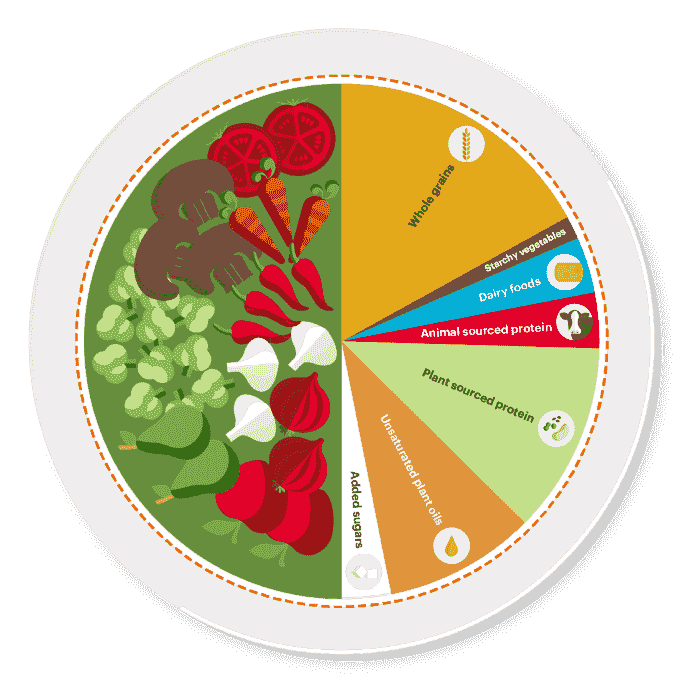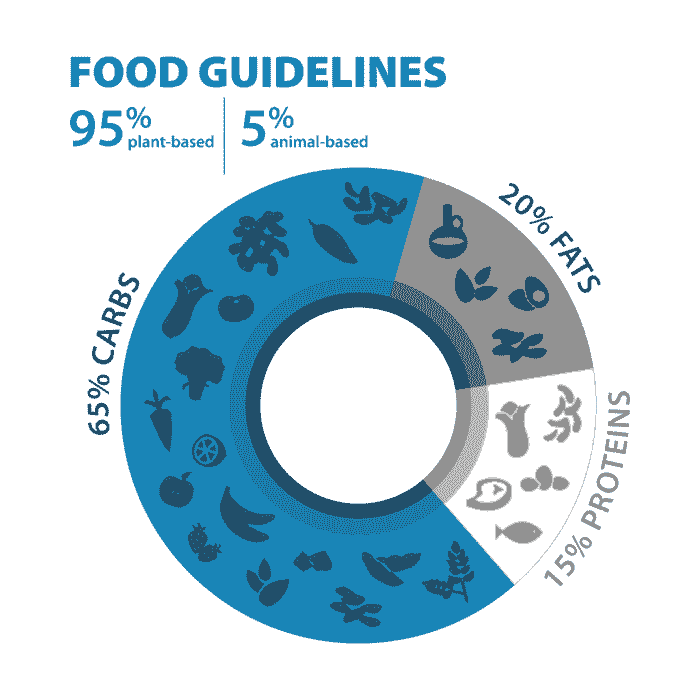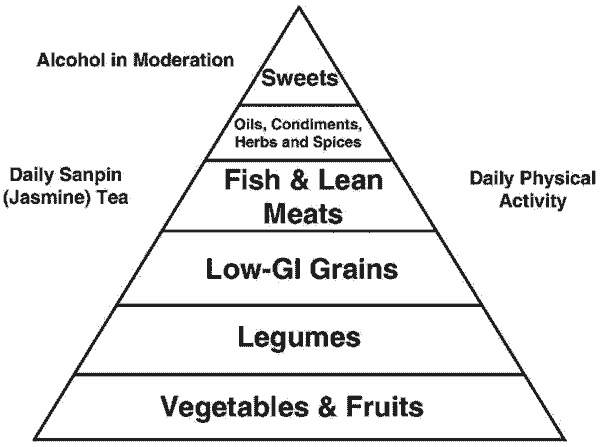If you're like most people, you consume food in the form of at least two meals every single day.
Because of that, your choices of food can have a disproportionate impact on your health, your energy, your productivity and pretty much every aspect of your life.
In fact, it can even affect your surrounding in a way that you might or might not have tuned into. This includes the quality of nearby soil, the quality of air and water, your regional climate or even the world's landscape.
Because of that, it makes sense for us to talk about the concept of sustainable diet, what it is, what it is consisted of, so that we can maximize the health of both ourselves and that of the planet.
What is a Sustainable Diet?
In a nutshell, a sustainable diet is a diet which meets all of our health needs without destabilizing our planet. It is to be contrasted with unsustainable diets, which are often optimized for one purpose at the cost of our other longer-term needs.
In other words, unlike sustainable diets, unsustainable diets can be often categorized by the function they try to fulfill. This leads to several key categories of unsustainable diets, which include, among others:
In fact, the tendency of many diets to overlook other major issues is what led the EAT-Lancet Commission, an independent commission with 37 scientists from 16 countries, to publish the first scientific guideline on sustainable diet: the planetary health diet.

And with the planetary health diet being a key proposed framework to achieve global food sustainability, the discussion on sustainable diet continues.
Criteria of a Sustainable Diet
So if a sustainable diet is one which promotes generational health for both ourselves and our planet, what criteria make them so? Here, while many criteria can obviously co-exist, they can also be broken down into three short clauses for practical purposes.
Low Environmental Impact
As it stands, the way we acquire food is often tied to our surrounding food production and delivery system. Here are the main steps that are usually involved in this process:
Because of that, it's imperative that we choose products that involve a minimal amount of steps and complexity, so that we can remain within planetary boundaries all of the while avoiding potential environmental hazards and unwarranted health risks.
For example, we do know that:
"Food systems have the potential to nurture human health and support environmental sustainability; however, they are currently threatening both. "
— "Food in the Anthropocene" (2019), EAT-Lancet Commission
The good news is, as bad as that sounds, there are still many things you can do as a consumer to minimize your exposure to these kinds of risks. For example, you can:
In the ideal scenario, this often translates into one adopting a quasi-vegetarian diet, with food either produced by oneself or acquired from nearby farms and markets.
Of course, this doesn't necessarily mean that all animal-derived food are bad or "unnatural", but that their consumption needs to be significantly curtailed to withstand the current populational demand.
And when you do, you might notice that not only you're more likely to end up with food that is more environmentally-friendly, but also food that is fresher, more nutritious, less processed and less polluted as well.
Satiety-inducing
Obviously, environmental friendliness on the basis of nutritional deficiency cannot be the way to go either, since this is basically your body's way of saying that your diet consistently fails to deliver all the nutrients that it needs.
Indeed, to fulfill these nutritional needs, not only do you need to get your fat, carbohydrate and protein intake beyond their thresholds, but you also need to do the same to your vitamins and minerals as well.
In fact, the blatant disregard of these needs can even lead to a series of disease symptoms, with some being more severe and less reversible than others. For example:
If anything, these effects are nowhere clearer than in people in the state of starvation, who, as they begin to lose body fat, muscles and organ functions, can also pass down their often-irreversible symptoms to their offspring as well.
Expectably, this scenario might seem a bit farfetched for those living in developed countries, but the truth is, even people in these countries can experience nutritional deficiency to some degree.
But the good news is, there's a way to mitigate these nutritional deficiencies without having to resort to calculation or measuring, and this has to do with choosing your food in a way that allows you to attain a sense of full-fledged satiety.
Obviously, this also means it won't be good enough if you just stuff yourself with celery, fruits, rice or even potatoes. Instead, you'd have to choose your food from certain "satiety categories" so that nutritional omni-directional sufficiency can be achieved.
In fact, eating for satiety is such an important concept in health that it's often overlooked by deprivation dieters such as fruitarians and vegans, who often end up with deficiencies that are later addressed via other less sustainable means.
Non-inflammatory
Just as insufficient nutrients can lead to a series of health problems, the opposite can also be true.
Indeed, when your nutritional intake consistently exceeds the amount needed for normal body functioning (as often is the case in developed countries), this overnutrition can also drive chronic inflammations in the body, leading to chronic diseases such as:
Because of that, it's just as important for you to choose food in a way that does not overtax your metabolic system, so that you can avoid turning food from a source of healing into a source of killing.
Fortunately, this can be done by simply restricting the consumption of certain ultra-nutrient-dense foods which are known to be inflammatory. These foods include, among others:
In fact, the search for non-inflammation diets often leads us back to the so-called traditional diets, where most — if not all — of the food is nutrient-diverse and minimally-processed.
Of course, the extent to which a food is inflammatory can also depend on the quantity of the food consumed. Because of that, restricting calories in a way that does not cause starvation is also a key habit that can assist this process.
In fact, by alternating between calorie-restricted feeding and fasting every day, it's also possible to benefit from the longevity boost frequently observed in lab animals such as rodents and monkeys, and the longest-lived people around the world.
Constituents of a Sustainable Diet
By using the criteria above and by relying on research on sustainable food production, centenarians and health, we arrive at the following framework of sustainable diet, which can be adjusted to fit one's biological profile and local environment.
For the most part, this framework shows that constituents of sustainable diets usually don't come with packages or nutritional facts. If anything, it shows that sustainable diets can be more aptly summarized as follows:
"Eat food. Not too much. Mostly plants."

Michael Pollan, In Defense of Food: An Eater's Manifesto (2008)
Key Macronutrient Categories
The following four food categories, categorized by their relative sizes, may be the most important components of your diet, since they are the ones that fit the three above criteria of sustainable diet the most.
In fact, when these categories form the main staple of your diet, it should be enough to get most of your carbohydrate, fat, protein, vitamin and mineral needs met.
Tubers
Tubers are large-size, starchy vegetables which are often the stem or the root of a plant. Prominent examples of tuber include, among others:
Because of their underground, dense-complex-carbohydrate nature, tubers often make a great source of energy with minimal residual impact on both our health and our environment.
However, when cooked in water or steamed, one should be careful not to overcook them. In fact, tubers are best eaten cold to prevent the starch from glycating our body.
Nuts
In a nutshell, nuts are small-to-medium-size dry fruits or seeds. Prominent examples of nut include, among others:
Because of their smaller sizes and relatively higher fat content, nuts make a great source of energy and a good alternative to conventional snacks.
However, because nuts are often adulterated or overly processed when packaged (e.g., cooked with oil), it's often safer to purchase them raw and process them later as needed.
Legumes
Legumes are small-to-medium-size fruits or seeds of plants, and are often represented by their key categories such as lentils and beans. Prominent examples of legume include, among others:
An interesting example of legume with a relatively higher fat content is soybean, which, even as its industrial cultivation remains controversial, is often repurposed into many different traditional food such as:
Since legumes are often low-calorie, high-protein and high-fiber in nature, this makes them a great source of energy that is naturally endowed with a longer shelf life.
However, because legumes are also composed in part of carbohydrates, it's often preferable to choose the larger size legumes, cook them well, and serve them cold to minimize their glycation impact.
Whole Grains
Whole grains are small-size seeds of certain types of grass. Prominent examples of whole grain include, among others:
Due to their high-carbohydrate, high-fiber nature, whole grains (and their minimally-processed derivatives such as sourdough bread and firm whole-grain bread) often make a good source of energy that is low in calories.
However, the starchy content of these grains also means that one should be wary of overcooking them, or otherwise consuming them in their refined forms (e.g., flour, industrial bread, cake, noodles, alcohol).
Key Micronutrient Categories
The following categories are key food categories that, while usually insufficient for providing the bulk of your nutritional needs, are almost universally agreed upon to be beneficial for health.
In fact, these categories are often known for the diverse range of micronutrients they provide (which are sometimes lacking in the above macronutrient categories), in addition to being generally anti-inflammatory and cleansing.
Fruits
Fruits are the ripen by-products of plants that are often better known for their sweet (or sour) taste. Prominent examples of fruit include, among others:
Since fruits are often high in fibers, vitamins and water, consuming 2+ servings of fruits after each meal can be a good way of ensuring that your body is relatively free of unwanted residues.
However, not all fruits are created equal, and one also needs to be wary of consuming fruits that are adulterated (e.g., waxed apples, unwashed pears) or high in sugar (e.g., overripe bananas, melons, purple grapes).
Vegetables
Vegetables are plants or parts of plant that come in the form of root, stem, leaf, flower or seed. Prominent examples of vegetable include, among others:
Since vegetables are often high in fibers, vitamins and minerals, they make a great source of micronutrients that are clean, low-calorie and anti-inflammatory.
However, because many vegetables are also prone to contaminations, it's often best to obtain them from local gardens or markets to minimize this possibility. If not, they should be purchased organic and washed thoroughly to prevent unwarranted risks.
Drinks
While usually not considered a part of a diet, drinks are nevertheless an essential part of food whose main functions are to prevent dehydration and to remove unwanted bodily residues.
Because of that, it is often preferable to stick to simple drinks such as warm water and tea, and to sip them every hour or so to reduce buildups in the body. 5+ cups of water every day, for example, is linked to a 50% reduction of heart disease.
Categories to Reconsider
The following categories are key food categories that, while great in providing abundant nutrition to the body, are to be consumed sparingly due to their inflammatory potential, disposition to pollution and their present/future ecological footprint.
Seafood
In its common usage, seafood refers to a series of plant and non-plant marine organisms whose "meaty" or vegetable portions are eaten by humans. Prominent examples of seafood include, among others:
Because seafood are often high in (animal) protein and minimally inflammatory, they can be a great constituent of a balanced diet and a viable alternative to other animal food.
However, when choosing seafood, extra care should be taken to make sure that the food is question is not contaminated, unsustainably produced or otherwise "meddled with" (e.g., chemical toxins, radioactive pollutants, mislabeling).
Fish
Fish is a special category of "meaty" seafood that is distinguished by its frequent consumption around the world. Prominent examples of fish include, among others:
Since fish possesses a relatively complete profile of fat and protein (including omega-3 fatty acids) and is minimally inflammatory, it can be adopted as a source of energy that is usually cleaner than other animal-based food.
However, when consuming fish, one should also take extra care to ensure that the fish is not contaminated, unsustainably-fished or otherwise "meddled with" (e.g., non-ecologically-certified, mercury-containing, polluted raw fish, overcooked fish).
Eggs
Eggs are offspring of birds or reptiles whose content comes in a shell, with the most commonly consumed ones being chicken eggs and duck eggs.
For the most part, eggs make a great, minimally inflammatory source of energy that is relatively abundant in fat and protein. However, preferences should be given to eggs that are pasture-raised, free-range, and generally organic.
White Meat
White meat, in a nutshell, refers to meat that is pale in color before and after cooking. Prominent examples of white meat — in this culinary sense — include chicken breast, turkey breast and pork.
While white meat provides a strong macronutrient profile that is relatively low in saturated fat (hence less inflammatory), extra care should still be taken to ensure that the meat is sustainably raised and contaminant-free (e.g., antibiotics, fecal matter).
Dairy
Dairy products are derivatives based on the milk of mammals (primarily cows). Prominent examples of dairy product include cow milk, yogurt, cheese, cream and butter.
While dairy products are often macronutrient-rich, their higher-saturated-fat nature also means that they can be inflammatory when consumed in large quantities.
(in fact, it is precisely because of that that dairy fat is often trimmed via industrial means.)
And because dairy production is often tied to the high-emission cattle industry, one should exercise caution by choosing products that are organic, non-polluted and generally sustainably produced (e.g., hormone-free, grass-fed, pasture-raised).
Categories to Avoid
The following categories contain key food groups that, while often convenient to consume, are generally assumed to be detrimental to both our health (e.g., inflammation-inducing) and our environment.
Red Meat and Processed Meat
Red meat and processed meat refer to meat that is dark and highly-refined, respectively. Examples of red meat include beef, veal and lamb, while examples of processed meat include bacon, sausage and smoked meat.
Because these meat categories are often tied to the cattle industry and are high in saturated fat and calories, their higher consumption can cause chronic inflammation in the body, which in turn is linked to a series of chronic diseases.
In fact, because these kinds of meat are generally expensive and carry a high environmental footprint, it's often best to replace them with other key macronutrient categories such as tuber, nut, whole grain and legumes.
Highly-processed Food
As the name suggests, highly-processed food is often so refined that it no longer resembles food in its original form. Examples of highly-processed food include, among others:
While all food can be technically considered processed, highly-processed food is distinctly unique in terms of its skewed nutritional profile (e.g., high-calorie, high-fat, high-salt), environmental impact, packaging and branding.
In fact, such food is often primarily designed for affordability, convenience and palatability rather than for health, and whose consumption is often linked to obesity and a list of other chronic diseases.
Refined Carbohydrates
Refined carbohydrates are food whose carbohydrate content are not embedded within fiber and has been broken down to the point of being alarmingly accessible to the body. Prominent examples of refined carbohydrates include, among others:
Since refined carbohydrates often lose the fiber and micronutrients they originally possess, their consumption can cause sugar spikes and inflammations in the body, leading to diseases such as obesity, type 2 diabetes, heart disease and tooth decay.
Chemically-processed Vegetable Oils
Chemically-processed vegetable oils are highly-processed liquids which often involve the chemical extraction of oil from seeds (e.g., hexane extraction). Examples of this kind of oil include, among others:
In general, chemically-processed vegetable oils tend to be high in omega-6 fatty acid — and hence pro-inflammatory. The fact that their fat tends to be less saturated also means they can oxidize and spoil quicker than their saturated counterpart as well.
For those reasons, it's generally preferable to consume whole food that naturally contains oil (e.g., olive, nuts, avocado), rather than resorting to consuming processed oils or food made with those oils.
"Transformation to healthy diets by 2050 will require substantial dietary shifts. Global consumption of fruits, vegetables, nuts and legumes will have to double, and consumption of foods such as red meat and sugar will have to be reduced by more than 50%. "

Prof. Walter Willett, co-chair of EAT-Lancet Commission
Examples of Sustainable Diets
In the previous section, we've provided a framework as to what constitutes (and does not constitute) a sustainable diet. In this section, however, we'll focus on some real-life examples of such diets to illustrate the case.
Blue Zone Diets
The Blue Zones, as popularized by Dan Buettner in his book carrying the same name, are a list of geographical areas with a high concentration of the longest-lived people in the world. According to Buettner, the five areas being identified are:
In fact, many of these areas even include historically isolated islands (such as Okinawa, Sardinia and Ikaria), whose lack of resources often forces its people to develop a self-sustaining way of life.
As a whole, the Blue Zones are not only known for their higher rates of centenarians, but also for their higher rates of people who are relatively happier and unaffected by diseases.
Food-wise, the people in the Blue Zones tend to adopt a diet that is 95%+ plant-based (such as the Ikarian diet and the Okinawa diet). The following are some of the most salient characteristics of their diet (as extracted from the Blue Zone Food Guideline):
Since the Blue Zones have a preference over plant-based, minimally-processed food, they tend to consume animal-based food and food of a refined nature sparingly. In particular:

Most interestingly, the people in the Blue Zones usually play an active role in their own food production/preparation process. In fact, this is often reflected in their own lifestyle as well.
"Almost all of the foods consumed by centenarians in the blue zones grow within a 10- mile radius of their homes. They eat raw fruits and vegetables; they grind whole grains themselves and then cook them slowly. They use fermentation[...], and pickled vegetables they eat."
Traditional Okinawan Diet
Okinawa, as one of the main islands of Japan and a designated Blue Zone, is a place known for its people and their health.
Indeed, Japan has already been for years the nation with the highest concentration of centenarians in the world, which makes Okinawa, a place whose elders have one of the highest life expectancies in Japan, the center in the study of diet and longevity.
Diet-wise, the traditional Okinawan diet is different from the increasingly westernized diet adopted by the younger Okinawans (e.g., year 2000 and onward), which has been linked to the decrease of life expectancy and centenarian rate in Okinawa.
However, many elders in Okinawa, who often work in farming and fishing in a tight-knit village-like community, still retain a large part of their diet, which is a quasi-vegetarian diet that is low in calories, fat, salt and added sugar.
At its core, the traditional Okinawan diet is based on tubers (rather than on rice or other grains), with Japanese sweet potatoes accounting for 50% or more of daily calories.
In fact, these sweet potatoes, which are native of Okinawa and contribute greatly to the island's self-sufficiency, have minimal impact on blood sugar level and are often featured in every meal (and usually eaten entirely from pulps, skin to leaves).
Aside from sweet potatoes, the traditional Okinawan diet also shares some similarities with those observed elsewhere in the Blues Zones. For example:
As with other Blue Zones, the traditional Okinawan diet is also relatively low on animal-based food. In particular:

In fact, the traditional Okinawan diet is consistent with many guidelines on healthy dietary patterns, with key recurring characteristics such as:
Food choices aside, the Okinawans also consume food in small plates and practice the so-called "hara hachi bu", a phrase cited before meals to remind them to eat up to 80% full, leading to an intake of around 1800 calories per day.
Towards Sustainable Diet
Wherever you live, your dietary choices will have an undeniable impact on your well-being and your surrounding ecology: some good, some bad.
Because of that, it's imperative that you refrain from consuming food of low nutritional/environmental caliber, so that you can avoid becoming wasted as a result of malnourishment, or diseased as a result of pollution and overnutrition.
Indeed, with the increased influence of humanity over the planet and its potential impacts on our healthspan and "worldspan", one can even argue that adopting a sustainable diet is now no longer a topic you can conveniently avoid.
The good news is, the transition towards sustainable diet is usually easier than you think, since in many cases, its constituents are often fresher, cheaper, healthier and easier to prepare.
In fact, the longer you can keep up with these constituents and avoid the bad ones, the longer, healthier and happier you and your surrounding biosphere can live.
If anything, the quest towards sustainable diet might even lead you to activities such as gardening and fishing, and a lifestyle that is more self-sufficient, more physically active, and generally more aligned with nature.
